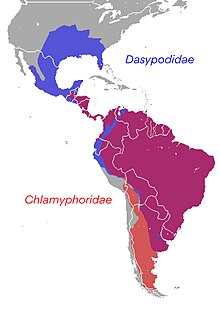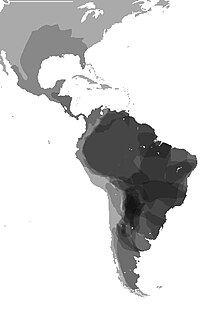
Back حزاميات Arabic حزاميات ARZ Cingulata AST Warkundoldunol (Cingulata) AVK Armadillər Azerbaijani کینقولاتا AZB Браняносцы Byelorussian Броненосци Bulgarian Cingulats Catalan Cingulata CEB
| Cingulata Temporal range: Late Paleocene[citation needed]-Recent,
| |
|---|---|

| |
| Glyptodon (Vienna) and Dasypus novemcinctus | |
| Scientific classification | |
| Domain: | Eukaryota |
| Kingdom: | Animalia |
| Phylum: | Chordata |
| Class: | Mammalia |
| Superorder: | Xenarthra |
| Order: | Cingulata Illiger, 1811 |
| Families | |

| |

| |
| The distribution and density of Cingulata species. | |
Cingulata, part of the superorder Xenarthra, is an order of armored New World placental mammals. Dasypodids and chlamyphorids, the armadillos, are the only surviving families in the order.[1] Two groups of cingulates much larger than extant armadillos (maximum body mass of 45 kg (100 lb) in the case of the giant armadillo[2]) existed until recently: pampatheriids, which reached weights of up to 200 kg (440 lb)[3] and chlamyphorid glyptodonts, which attained masses of 2,000 kg (4,400 lb)[4] or more.
The cingulate order originated in South America during the Paleocene epoch about 66 to 56 million years ago, and due to the continent's former isolation remained confined to it during most of the Cenozoic. However, the formation of a land bridge allowed members of all three families to migrate to southern North America during the Pliocene[5] or early Pleistocene[6] as part of the Great American Interchange. After surviving for tens of millions of years, all of the pampatheriids and giant glyptodonts apparently died out during the Quaternary extinction event at the beginning of the Holocene,[7][8] along with much of the rest of the regional megafauna, shortly after the colonization of the Americas by Paleo-Indians.
- ^ Gardner, A.L. (2005). "Order Cingulata". In Wilson, D.E.; Reeder, D.M (eds.). Mammal Species of the World: A Taxonomic and Geographic Reference (3rd ed.). Johns Hopkins University Press. pp. 94–99. ISBN 978-0-8018-8221-0. OCLC 62265494.
- ^ Giant Armadillo Priodontes maximus (Kerr, 1792). FaunaParaguay.com
- ^ Vizcaíno, S. F.; De Iuliis, G.; Bargo, M. S. (1998). "Skull Shape, Masticatory Apparatus, and Diet of Vassallia and Holmesina (Mammalia: Xenarthra: Pampatheriidae): When Anatomy Constrains Destiny". Journal of Mammalian Evolution. 5 (4): 291–322. doi:10.1023/A:1020500127041. S2CID 20186439.
- ^ Blanco, R. E.; Jones, W. W.; Rinderknecht, A. (2009-08-26). "The sweet spot of a biological hammer: the centre of percussion of glyptodont (Mammalia: Xenarthra) tail clubs". Proceedings of the Royal Society B: Biological Sciences. 276 (1675): 3971–3978. doi:10.1098/rspb.2009.1144. ISSN 0962-8452. PMC 2825778. PMID 19710060.
- ^ Mead, J. I.; Swift, S. L.; White, R. S.; McDonald, H. G.; Baez, A. (2007). "Late Pleistocene (Rancholabrean) Glyptodont and Pampathere (Xenarthra, Cingulata) from Sonora, Mexico" (PDF). Revista Mexicana de Ciencias Geológicas. 24 (3): 439–449 (see p. 440). Retrieved 2013-06-15.
- ^ Woodburne, M. O. (2010-07-14). "The Great American Biotic Interchange: Dispersals, Tectonics, Climate, Sea Level and Holding Pens". Journal of Mammalian Evolution. 17 (4): 245–264 (see p. 249). doi:10.1007/s10914-010-9144-8. ISSN 1064-7554. PMC 2987556. PMID 21125025.
- ^ Hubbe, A.; Hubbe, M.; Neves, W. A. (March 2013). "The Brazilian megamastofauna of the Pleistocene/Holocene transition and its relationship with the early human settlement of the continent". Earth-Science Reviews. 118: 1–10 (see pages 3, 6). Bibcode:2013ESRv..118....1H. doi:10.1016/j.earscirev.2013.01.003. ISSN 0012-8252.
- ^ Fiedal, Stuart (2009). "Sudden Deaths: The Chronology of Terminal Pleistocene Megafaunal Extinction". In Haynes, Gary (ed.). American Megafaunal Extinctions at the End of the Pleistocene. Vertebrate Paleobiology and Paleoanthropology. Springer. pp. 21–37 (see p. 31). doi:10.1007/978-1-4020-8793-6_2. ISBN 978-1-4020-8792-9. OCLC 313368423.
© MMXXIII Rich X Search. We shall prevail. All rights reserved. Rich X Search